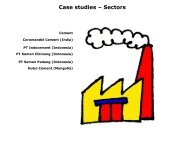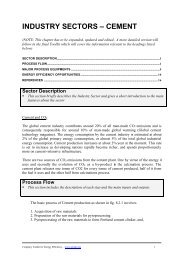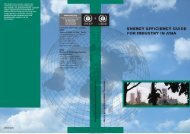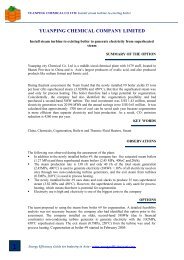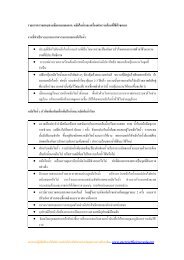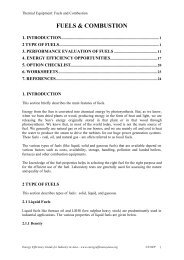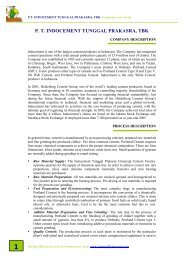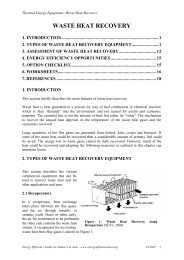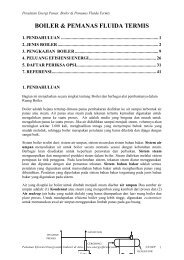Chapter – Cooling Towers - RETScreen International
Chapter – Cooling Towers - RETScreen International
Chapter – Cooling Towers - RETScreen International
You also want an ePaper? Increase the reach of your titles
YUMPU automatically turns print PDFs into web optimized ePapers that Google loves.
Electrical Energy Equipment: <strong>Cooling</strong> <strong>Towers</strong>tower has to be chosen, then the approach is most important, closely followed by the flowrate, and the range and wet bulb would be of lesser importance.Approach (5.5 0 C) = Cold-water temperature 32.2 0 C <strong>–</strong> Wet bulb temperature (26.70 C)4.1.4 Heat loadThe heat load imposed on a cooling tower is determined by the process being served. Thedegree of cooling required is controlled by the desired operating temperature of the process.In most cases, a low operating temperature is desirable to increase process efficiency or toimprove the quality or quantity of the product. However, in some applications (e.g. internalcombustion engines) high operating temperatures are desirable. The size and cost of thecooling tower is increases with increasing heat load. Purchasing undersized equipment (if thecalculated heat load is too low) and oversized equipment (if the calculated heat load is toohigh) is something to be aware of.Process heat loads may vary considerably depending upon the process involved and aretherefore difficult to determine accurately. On the other hand, air conditioning andrefrigeration heat loads can be determined with greater accuracy.Information is available for the heat rejection requirements of various types of powerequipment. A sample list is as follows (BEE, 2004):• Air Compressor- Single-stage - 129 kCal/kW/hr- Single-stage with after cooler - 862 kCal/kW/hr- Two-stage with intercooler - 518 kCal/kW/hr- Two-stage with intercooler and after cooler - 862 kCal/kW/hr• Refrigeration, Compression - 63 kCal/min/TR• Refrigeration, Absorption - 127 kCal/min/TR• Steam Turbine Condenser - 555 kCal/kg of steam• Diesel Engine, Four-Cycle, Supercharged - 880 kCal/kW/hr• Natural Gas Engine, Four-cycle - 1523 kCal/kW/hr (= 18 kg/cm 2 compression)4.1.5 Wet bulb temperatureWet bulb temperature is an important factor in performance of evaporative water coolingequipment, because it is the lowest temperature to which water can be cooled. For this reason,the wet bulb temperature of the air entering the cooling tower determines the minimumoperating temperature level throughout the plant, process, or system. The following should beconsidered when pre-selecting a cooling tower based on the wet bulb temperature:• Theoretically, a cooling tower will cool water to the entering wet bulb temperature. Inpractice, however, water is cooled to a temperature higher than the wet bulb temperaturebecause heat needs to be rejected from the cooling tower.• A pre-selection of towers based on the design wet bulb temperature must considerconditions at the tower site. The design wet bulb temperature also should not beexceeded for more than 5 percent of the time. In general, the design temperature selectedis close to the average maximum wet bulb temperature in summer.• Confirm whether the wet bulb temperature is specified as ambient (the temperature inthe cooling tower area) or inlet (the temperature of the air entering the tower, which isoften affected by discharge vapors recirculated into the tower). As the impact ofEnergy Efficiency Guide for Industry in Asia <strong>–</strong> www.energyefficiencyasia.org ©UNEP 10



